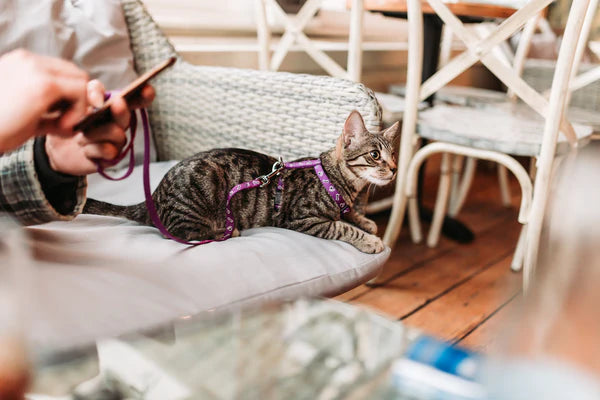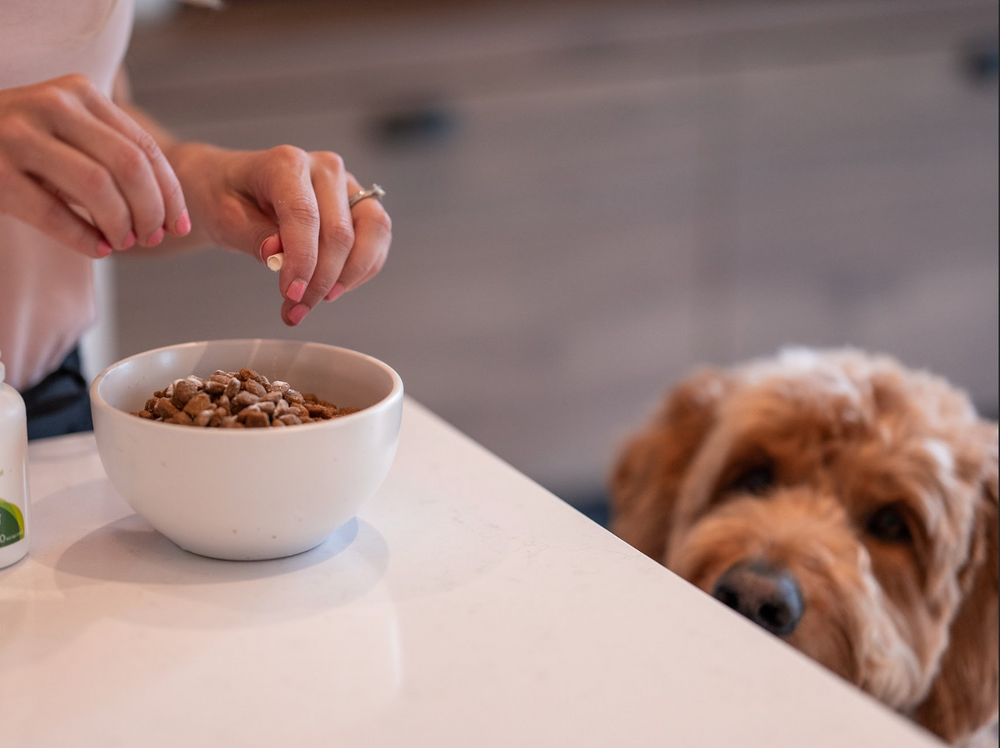6 Simple Ways to Give Your Indoor Cat a Workout 2023
Making it a point to give your home-bound cat a regular workout is essential to help him stay healthy and happy. Not doing so can make your beloved furry friend vulnerable to a number of health problems sooner or later. Besides being prone to unwanted weight gain, many cats are also subject to boredom and anxiety if they're not being kept regularly active.
- Click to learn more : 👉 Provide support in EXERCISING AN INDOOR CAT with our Natural Product 🐱
And unlike what a lot of pet owners mistakenly believe, regular cat exercise is a must for both older cats and kittens! Remember that playtime isn't just for dogs and you don't have to spend a lot on a cat toy, too. The type of interactive play and intensity levels vary depending on the age and physical state of a cat, though.
If you’re still having a tricky time getting in on simple and practical ways when it comes to giving a bored cat a workout, then you’ve come to the right place. Read on to discover some no-fuss feline exercise ideas (even without exercise equipment) that will surely catch your cat's interest.
The Importance of Exercising an Indoor Pet

Cat exercise is more than just engaging your pet in a play session to avoid unwanted weight gain. There are basically two (2) key reasons why your indoor-bound kitty needs cat exercise on a regular basis:
Exercise promotes and maintains cat bone and muscle strength.
First, it helps keep the muscles and bones of your cat strong, which prevents problems like sprains and accelerated degeneration of the joints. As an added benefit, the constant movement also keeps obesity-related health issues like hypertension, heart disease, as well as diabetes at bay.
Working out helps release cat stress and anxiety.
Second, giving your indoor kitty a workout is a fun way to get rid of stress and anxiety. Apart from nipping negative cat behaviors in the bud like aggression, destructive scratching and urine spraying, regular cat exercise is an outlet for you and your pet to become even more close-knit, too.
How Much Exercise Does an Indoor Feline Need?

While it is essential to keep your cat active, it's important to remember that cat workouts should be fun and not something your pet will find exhausting! Even veterinary medicine adheres to this guideline if you're looking to get your cat to exercise.
An indoor kitty requires at least 20 minutes of exercise per day. However, it is important to consider the age and current health status of your cat before engaging him in a playtime/workout session.
One strategy to help ensure that your cat gets the exercise he needs without making him prone to injury is to split the whole thing into four 5-minute periods. Continue playing when he's already had some time to rest.
I recommend starting with a couple of minutes of moderate exercise to get your cat going then cranking it up to intense for the rest of the remaining time. Hiding treats here and there will also make your cat become more motivated to participate.
Adverse Effects of Not Exercising an Indoor Cat

Unlike what a lot of people mistakenly think, your kitty won’t just be putting on extra weight if he doesn’t get the right amount of exercise he needs every day. He is also at risk of the following physical and mental health issues sooner or later:
- Muscle and ligament injury
- Arthritis and joint deterioration
- Heart disease
- Hypertension
- Diabetes in cats (can also involve weight loss)
- Anxiety
- Very high levels of stress
- Aggression
- Destructive behaviors
Additionally, scientific studies reveal that the lack of exercise in indoor cats can also lead to feline obsessive-compulsive disorder (OCD), along with other factors such as social and environmental stress.
While not all cats may be at risk of this mental health issue, it will still be very helpful to get your cat moving regularly. Other signs of OCD include sudden changes in eating habits, isolation from other pets and lack of interest in play.
Simple Ways to Give your Indoor Kitty a Workout
Here are some cool and no-fuss indoor feline exercise tips that both you and your cat will surely enjoy:
1. Activate your cat’s natural stalking and hunting instincts

Did you know that cats are natural hunters? Even small kittens already have this attribute. Astudy published in the British Ecological Society highlights that while indoor cats spend most—if not all—of their time inside the house, this doesn’t take away their inherent stalking and hunting instincts.
And you can take advantage of this to give your pet regular cat exercise! Cats love to stalk and chase things. You can even get your cat in hunting mode by using wand toys and laser pointers. You can even integrate small treats in your regular exercise to really get your cat going.
A toy doesn't have to be expensive, too. One simple way to pull this off is by tying a ribbon to a piece of string and dragging the whole thing on the floor continuously. This mimics the movement of a mouse or some other small animal that cats love to creep up on. Get ready for some really intense cat workouts!
2. Having a playmate makes a lot of difference.

Another approach to encourage your resident indoor feline to move more is by getting him a companion kitty or a dog buddy. Cats often like to do things together like poking things with their paws, jumping in excitement, as well as grooming and lounging. The same goes for playing, too.
Veterinary medicine even recommends early socialization to prevent problematic behavior in the long run. However, there are important factors to take note of when choosing a companion cat. Besides selecting a kitty that is as old as your resident feline, it is crucial to go for one that has a similar temperament as well.
One thing to remember, though. Cats may not hit it off immediately with their playmate, be it with other cats or dogs. Be extra patient with their unexpected squabbles here and there. These usually involve toys, food, or some treat. Just make sure to monitor them regularly.
3. The laser pointer trick never fails.

In lieu of natural prey like birds, rodents, and other small animals inside your home, you can use a laser pointer to set off this attribute instead to give him a workout. The green or red dot will definitely get his play mode in gear.
Just keep in mind to go for "red" laser toys because they are significantly weaker compared to their counterparts, but still as eye-catching. You can even use this toy to make your pet jump, walk to a different place, or even give chase!
It's important to aim the laser toy at the floor or the wall and not directly at your cat’s eyes to avoid potential damage. Take the lead in playing with a laser toy or laser pointers by consistently moving from one place to another as you go along.
4. Stimulate your kitty’s mind by using cat toys.

Another way to give your kitty the exercise he needs is by introducing cat puzzle toys or cat toys with an added twist to them. Besides motivating him to become more engaged during playtime, this will also help stimulate his mind a lot. You can even turn mealtime into a play session with these types of cat toys.
Some cat parents integrate puzzle toys with food or a treat to really make their pets active. A cat exercise wheel gets the job done, too. No need to get your hands on big-budget cat toys, too.
One way to do this is to stuff an empty tissue roll with a few cat treats and then tightly seal both ends with paper and tape. The rattling sound will get your pet’s inquisitive side going, while the smell of the treats will give him the idea that there’s a reward waiting for him.
5. Take cat exercise to new heights using cat trees.

The Scientific American shares that cat claws are designed to climb surfaces almost effortlessly. Giving your cat appropriate places to clamber up inside your home like a cat tree is one strategy you can use to get your pet to become more active. Cat trees help keep most cats active without putting them at risk of injury.
When choosing a cat tree or cat patio for your pet, keep in mind to go for those made from solid wood. Besides being sturdy and stable, they can also hold your kitty’s weight really well for quite a long time. You can even go for a multi-story cat tree to take the fun and play to a whole new "level!"
6. Leash training works for cats as well.

While this may sound surprising, you can use a leash to walk your cat as a form of exercise. The first step to pulling this off is making your pet feel comfortable wearing a harness indoors.
And when you observe that your pet has already become comfortable with the harness, attach a leash to it and try leading and maneuvering your cat around your home. Although this may take a bit of training (and a lot of goading, too), the payoff will definitely be worth it.
A Few Extra Tips To Make Cats Respond to a Workout Regimen
As a pet parent myself, I understand that following a regular exercise regimen for your cat can be a bit challenging. Just follow these tips and you'll be alright:
Schedule regular yet feasible times for play with your cat.
Go for realistic schedules when setting up a regular workout for your cat. You can do this during your downtime or when your schedule is expected to be already open. Remember that exercise is not just for dogs. Cats need it, too.
Having treats in your checklist is a useful tool.
Encouraging cats to be more participative is not that tricky. One strategy you can go for is to combine play and food. Puzzle toys with a hidden treat will surely excite your cat in no time. Just make sure the food is appropriate for your pet and you're good to go.
Playtime should be fun and not a job.
Your cat won't be that excited to get in on the play action if he thinks it's too exhausting. Whether you're looking to take your cat for a walk or make him more active using toys, remember that treating exercise as play should always be the priority.
Always do your research before grabbing stuff (like a cat exercise wheel) at the pet store.
Toys for cats can be a bit expensive. However, it's crucial to keep in mind that toys are already more durable or more enjoyable for cats if they have a higher price tag. Make sure you compare prices and check out reviews before shopping for toys for cats.
Patience is crucial when encouraging your cat to participate.
Inspiring a cat to exercise isn't an instant deal. Most cats will need a lot of reassuring before they can really get in on the action—like making your cat slip into a harness. Encouraging him with food works really well.
Now, here’s a quick reminder to help keep indoors cats as healthy and happy as can be…
Indoor Cats can be Susceptible to Health Issues, too!
Zumalka’s IMMUNOPET helps your cat build a strong and resilient immune system to help him fight against numerous types of bacterial and viral infections. This natural product also promotes an increase in hemoglobin levels and acts as a purifier of blood and lymph nodes.
IMMUNOPET combines top-quality natural ingredients with a gentle holistic approach to help make sure that your cat’s immune system is always ready for action without making him prone to adverse side effects sooner or later.
A Final Word
In case your pet is going through an illness, and you’d like to have a more personalized solution for your pet's health concerns, make sure you check out our ONLINE HOMEOPATHIC CONSULTATION right now.
Each consultation targets the root of your pet's problem, instead of just dealing with the symptoms. And if you’ve already tried all conventional treatments possible with little to no convincing results, our ONLINE HOMEOPATHIC CONSULTATION also features a pet-friendly comprehensive approach to give you the best natural solutions instead of guesswork.







Leave a comment